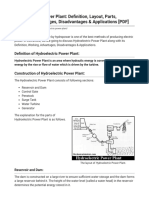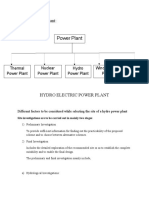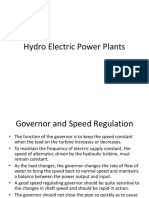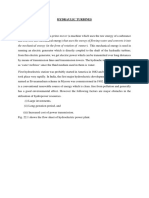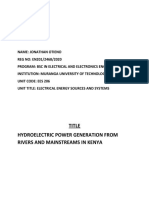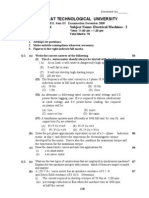67%(3)67% found this document useful (3 votes)
7K viewsHydro Power Plant
Hydro Power Plant
Uploaded by
Shailesh SankdasariyaREFERANCE. CONCLUSION. STATUS ADVANTAGES & DISADVANTAGES. VARIOUS FACTOR VARIOUS TYPES WORKING BLOCK DIAGRAM&IT’S COMPONANTS.
Copyright:
Public Domain
Available Formats
Download as PDF, TXT or read online from Scribd
Hydro Power Plant
Hydro Power Plant
Uploaded by
Shailesh Sankdasariya67%(3)67% found this document useful (3 votes)
7K views8 pagesREFERANCE. CONCLUSION. STATUS ADVANTAGES & DISADVANTAGES. VARIOUS FACTOR VARIOUS TYPES WORKING BLOCK DIAGRAM&IT’S COMPONANTS.
Copyright
© Public Domain
Available Formats
PDF, TXT or read online from Scribd
Share this document
Did you find this document useful?
Is this content inappropriate?
REFERANCE. CONCLUSION. STATUS ADVANTAGES & DISADVANTAGES. VARIOUS FACTOR VARIOUS TYPES WORKING BLOCK DIAGRAM&IT’S COMPONANTS.
Copyright:
Public Domain
Available Formats
Download as PDF, TXT or read online from Scribd
Download as pdf or txt
67%(3)67% found this document useful (3 votes)
7K views8 pagesHydro Power Plant
Hydro Power Plant
Uploaded by
Shailesh SankdasariyaREFERANCE. CONCLUSION. STATUS ADVANTAGES & DISADVANTAGES. VARIOUS FACTOR VARIOUS TYPES WORKING BLOCK DIAGRAM&IT’S COMPONANTS.
Copyright:
Public Domain
Available Formats
Download as PDF, TXT or read online from Scribd
Download as pdf or txt
You are on page 1of 8
Hydro Power Plant
ENERGY SYSTEMS,
BY SHAILESH B. PATEL 090760111025
HYDRO-ELECTRIC
POWER PLANT
CONTENTS:-
BLOCK DIAGRAM & IT’S COMPONANTS.
WORKING OF HYDRO ELECTRIC POWER PLANT.
CLASSIFICATION OF HYDRO ELECTRIC POWER PLANT.
SITE SELECTION FOR HYDRO ELECTRIC POWER PLANT.
ADVANTAGES & DISADVANTAGES.
KEY FACTS ABOUT HYDRO ELECTRIC POWER PLANT.
STATUS OF HYDRO ELECTRIC POWER PLANT IN INDIA.
CONCLUSION.
REFERANCE.
RSAGQAAARA
HYDRO-ELECTRIC POWER PLANT
ENERGY SYSTEMS
SANKDASARIYA SHAILESH B.
ENRL NO-090760111025
SSASIT (E.C. DEPARTMENT)
Hydro Power Plant
ENERGY SYSTEMS
BY SHAILESH B. PATEL -090760111025
@ AIM:- 10 STUDY ABOUT HYDRO POWER PLANT.
Hydroelectricity is one of the main forms of energy in use today. Its use is being promoted in many
countries of the world as a renewable and non-polluting source of energy. Hydroelectricity is produced
in a hydroelectric power plant. in this plant, the water is released from a high location. The potential
energy present in the water is converted into kinetic energy, which is then used to rotate the blades of a
turbine, The turbine is hooked to the generator which produces electricity.
BLOCK DIAGRAM:-
@COMPONANTS:-
‘The water flowing in the river comprises of kinetic energy and potential energy. In hydroelectric power
plants the potential energy of water is utilized to produce electricity. There are eight important
components of the hydroelectric power plant. All these components and their working have been
described below:
Dam
Water reservoir
Intake or control gates
The penstock
‘Water turbines
Generators
Transformer,
Tailrace
eeennree
ssasiT | BY SHAILESH 8, PATEL(E.. DEPARTMENT) SAM
Hydro Power Plant
ENERGY SYSTEMS
BY SHAILESH B. PATEL -090760111025
1) DAM:-_The dam is the most important component of hydroelectric power plant. In fact the name
‘damn’ is considered to be synonymous to the ‘hydroelectric power plant’ The dam is built on a large
river that has abundant quantity of water throughout the year. The dam is buift at location where the
height of the river is sufficiently high so as to get maximum possible potential energy from water.
2) WATER RESERVOIR:-_ Water reservoirs the place behind the dam where water is stored.
‘The water in the reservoir is located at the height above the rest of the dam structure. The height of
water in the reservoir decides how much potential energy water possesses. Higher the height of water
more is its potential energy. The high position of water in the reservoir also enables it to move
downwards effortlessly due to gravity. The height of water in the reservoir is higher than the natural
height of water flowing in the river, hence water in reservoir is considered to be altered equilibrium,
This also helps to increase the overall potential energy of water, which helps ultimately produce more
electricity in the power generation unit.
3) INTAKE OR CONTROL GATES:-_ these are the gates built on the inside of the dam. The
water from reservoir is released and controlled through these gates. These are called inlet gates because
water enters the power generation unit through these gates. When the control gates are opened the
water flows due to gravity through the penstock and towards the turbines. The water flowing through
the gates possesses potential as well as kinetic energy.
4) THE PENSTOCK:- The penstock is the long pipe or the shaft that carries the water flowing
from the reservoir towards the power generation unit that comprises of the turbines and generator. The
water in penstock possesses kinetic energy due to its motion and potential energy due to its height. The
total amount of power generated in the hydroelectric power plant depends on the height of the water
reservoir and the amount of water flowing through the penstock. The amount of water flowing through
the penstock is controlled by the control gates.
5) WATER TURBINES:-_ The water flowing from the penstock is allowed to enter the power
generation unit that comprises of the turbines and generator. When water falls on the blades of the
turbine the kinetic and potential energy of water is converted into the rotational motion of the blades of
the turbine. Due to rotation of blades the shaft of the turbine also rotates. The turbine shaft is enclosed
inside the generator. In most of the hydroelectric power plants there are more than one power
generation units comprising of the turbine and generator.
There is large difference in height between the level of turbine and level of water in the water reservoir.
This difference in height, also called as head of water, decides the total amount of power that can be
generated in the hydroelectric power plant.
6) GENERATORS::. tis in the generator where the electricity is produced. The shaft of the water
turbine rotates in the generator, which produces alternating current in the coils of the generator. It is
the rotation of the shaft inside the generator that produces magnetic field which is converted into
electricity by electromagnetic field induction. Hence the rotation of the shaft of the turbine is crucial for
the production of electricity and this is achieved by the kinetic and potential energy of water. Thus in
hydroelectricity power plants potential energy of water is converted into electricity.
ssasiT | BY SHAILESH 8, PATEL(E.C. DEPARTMENT) [ERI
Hydro Power Plant
ENERGY SYSTEMS
BY SHAILESH B. PATEL -090760111025
7) TRANSFORMER:. The electricity generated inside the generator is not of sufficient voltage.
The transformer converts the alternating current produced from within the generator to the high
voltage current. Current is supplied to the supply coil, from where it passes to the outlet coil. The power
supply from the transformer is connected to the nation grid, from where the power is distributed for the
domestic and industrial use.
8) TAILRACE:
‘The water that has been used to rotate the turbine blades and turbines shaft leaves the power
generation unit entering the pipeline called as the tailrace. From here the water flows into the main
river. The height of water in the tailrace is much below the height of water in the water reservoir behind
the dam, The potential energy of water in the tailrace has been used to generate electricity.
The water flowing out from the tail race joins the natural flow of water. During the rainy seasons when
there is excess water in the dams, its allowed to overflow through the gates in water reservoir to the
low level natural flow of water. Ifthe river is very large, then multiple dams can be constructed across
the river at various locations.
@WORKING PRINCIPLE OF HYDRO-ELECTRIC POWER PLAN’
Head
Head Water
Race Pond
ses
Penstock
Power House with
Turbine & Pumps
4 taitRace
Tail Water
Pond
‘The water flowing in the river possesses two type of energy: the kinetic energy due to flow of water and
potential energy due to the height of water. in hydroelectric power plants or dams potential energy of
water is utilized to generate electricity.
The formula for total power that can be generated from water in hydroelectric power plant due to its
height is given by
P=rhg
Where: P is the total power that can be produced in watts
r-is the flow rate of water measured in cubic meters per second.
h- is called height of water measured in meters. Its also head of water. Itis difference in height
between the source of water (from where water is taken) and the water's outflow (where the water is
used to generate electricity, it is the place near the turbines}.
g-is the gravity constant 9.81 m/second square
ssasiT | BY SHAILESH , PATEL(E.C. DEPARTMENT)
Hydro Power Plant
ENERGY SYSTEMS
BY SHAILESH B. PATEL -090760111025
The formula clearly shows that the total power that can be generated from the hydroelectric power
plants depends on two major factors: the flow rate of water or volume of flow of water and height or
head of water. More the volume of water and more the head of water more is the power produced in
the hydroelectric power plant.
To obtain the high head of water the reservoir of water should as high as possible and power generation
unit should be as low as possible. The maximum height of reservoir of water is fixed by natural factors
like the height of river bed, the amount of water and other environmental factors. The location of the
power generation unit can be adjusted as per the total amount of power that is to be generated. Usually
the power generation unit is constructed at levels lower than ground level so as to get the maximum
head of water.
The total flow rate of water can be adjusted through the penstock as per the requirements. if more
power is to be generated more water can be allowed to flow through it.
CLASSIFICATION OF HYDRO-PLAN’
In hydro-plants, water is collected behind the dam. This reservoir of water may be classified as
either storage or pondage according to the amount of water flow regulation they can exert. The
function of the storage is to impound excess river flow during the rainy season to supplement the low
rates of flow during dry seasons. They can meet the demand of load fluctuations for six months or even
fora year. Pondage involves in storing water during low loads so that this water can be utilized for
carrying the peak loads during the week. They can meet the hourly or weekly fluctuations of load
demand. With poundage, the water level always fluctuates during operations It rises at the time of
storing water, falls at the time ‘off drawing water, remains constant when the load is constant.
The hydro-power plants can be classified as below:
1. Storage plant 2. Run-of-river power plants 3. Pumped storage power Plants.
(a) High head plants (a) With pondage
(b) Low head plants (b) Without pondage.
(c) Medium head plants.
STORAGE PLANT:
1) LOW HEAD HYDROELECTRIC POWER PLANT!
The low head hydroelectric power plants are the ones in which the available water head is less than 30
meters.
2) MEDIUM HEAD HYDROELECTRIC POWER PLANTS:
The hydroelectric power plants in which the working head of water is more than 30 meters but less than
300 meters are called medium head hydroelectric power plants.
3) HIGH HEAD HYDROELECTRIC POWER PLANTS:-
In the high head hydroelectric power plants the head of water available for producing electricity is more
than 300 meters and it can extend even up to 1000 meters.
ssasiT | BY SHAILESH 8. PATEL(E.C. DEPARTMENT) [ER
Hydro Power Plant
ENERGY SYSTEMS
BY SHAILESH B. PATEL -090760111025
®@RUN-OF-RIVER POWER PLANTS:
1) RUN-OFF RIVER HYDROELECTRIC PLANTS WITHOUT POND:-
In the run-off river type of hydroelectric power plants the running water of the river is used for the
generation of electricity. There is no facility for storing the water.
2) RUN-OFF RIVER HYDROELECTRIC PLANTS WITH POND:
These types of run-off river hydroelectric power plants usually produce the power during peak loads.
During the day-time and off-peak periods they don’t produce power and the water is stored in large
pond
©PUMPED STORAGE POWER PLANTS:
These plants supply the peak load for the base load power plants and pump all or a portion of
their own water supply.
SELECTION OF SITE FOR A HYDRO-ELECTRIC POWER PLANT:
‘Some point that should be given importance while selecting a site for Hydro-electric power stationis
given below.
1) AVAILABILTY OF WATER:
Since the primary requirement for a hydro electric power station ,is the availability of huge amount of
water such plants should be built at a place(eg.river,canal)where adequate water is available at a good
head.
2) STORAGE OF WATE!
There are wide variations in water supply from a river or canal during the year. This makes its necessary
to store water by constructing a dam inorder to ensure the generation of power through out the
year.The storage helps in equalising the flow of water so that any excess quantity of water at a certain
period of the year can be made available during times of very low flow in the river.This leads to the
conclusion that site selected for hydro electric plant should provide adequate facilities for erecting a
dam and storage of water.
3) COST AND TYPE OF LANI
The land for the construction of plant should be available at a reasonable price.Further ,the bearing
capacity of the soil should be adequate to withstand the installation of heavy equipment.
4) TRANSPORTATION FACILITIES:-
The site selected for the hydro-electric plant should be accessible by rail and road so that necessary
‘equipment and machinery could be easily transported.
Itis clear from the above mentioned factors that ideal choice of site for such a plant is near a river in
hilly areas where dam can be conveniently built and large reservoirs can be obtained.
SSASIT | BY SHAILESH B. PATEL(E.C. DEPARTMENT) [fq
Hydro Power Plant
ENERGY SYSTEMS
BY SHAILESH B. PATEL -090760111025
ADVANTAGES & DISADVANTAGES OF HYDRO POWER
PLANTS:
ADVANTAGES:
1, Renewable source of energy thereby saves scares fuel reserves.
Economical source of power.
Non-polluting and hence environment friendly.
Reliable energy source with approximately 90% availabilty.
Low generation cost compared with other energy sources.
Indigenous, inexhaustible, perpetual and renewable energy source.
Low operation and maintenance cost.
Possible to build power plant of high capacity.
Plant equipment is simple.
10. Socio-economic benefits being located usually remote areas.
11. Higher efficiency, 9596t098%.
12, Fuel is not burned so there is minimal pollution
13. Water to run the power plant is provided free by nature
14.It's renewable - rainfall renews the water in the reservoir, so the fuel is almost always there.
DISADVANTAGES:
Susceptible to vagaries of nature such as draught.
Longer construction period and high initial cost.
Loss of large land due to reservoir.
Non-availability of suitable sites for the construction of dam.
Displacement of large population from reservoir area and rehabilitation.
Environmental aspect reservoirs verses river ecology.
High cost of transmission system for remote sites.
‘They use up valuable and limited natural resources
‘They can produce a lot of pollution
10.Companies have to dig up the Earth or drill wells to get the coal, oil, and gas
11L.For nuclear power plants there are waste-disposal problems.
PEN AVENE
KEY FACTS ABOUT HYDRO POWER PLANT:-
World-wide, about 20% of all electricity is generated by hydropower.
‘WHydropower is clean. It prevents the burning of 22 billion gallons of oil or 120 million tons of coal each
year.
‘WHydropower does not produce greenhouse gasses or other air pollution.
‘WHydropower leaves behind no waste.
‘Hydropower is the most efficient way to generate electricity. Modern hydro turbines can convert as.
much as 90% of the available energy into electricity. The best fossil fuel plants are only about 50%
efficient,
‘Hydropower is the leading source of renewable energy. It provides more than 97% of all electricity
generated by renewable sources. Other sources including solar, geothermal, wind, and biomass account
for less than 3% of renewable electricity production.
‘© Water is a naturally recurring domestic product and is not subject to the whims of foreign suppliers.
Hydro Power Plant
ENERGY SYSTEMS
BY SHAILESH B. PATEL -090760111025
HYDRO POWER PLANTS
STATION
Srisailam Dam
Nagarjunasagar
‘Sardar Sarovar
Baspa-ll
Nathpa Jhakri
Bhakra Dam
Dehar
Baira Suil
‘Chamera-|
Chamera-tI
Pong
Uri Hydroelectric Dam
Dulhasti
Salal
Sharavathi
Kalinadi
Linganamakki Dam
Bansagar Dam
‘STATE
Andhra Pradesh
‘Andhra Pradesh
Gujarat
Himachal Pradesh
Himachal Pradesh
Punjab
Himachal Pradesh
Himachal Pradesh
Himachal Pradesh
Himachal Pradesh
Himachal Pradesh
Jammu & Kashmir
Jammu & Kashmir
Jammu & Kashmir
Kamataka
Kamataka
Kamataka
Madhya Pradesh
Bargi Dam Madhya Pradesh
Madikheda Dam Madhya Pradesh
‘Omkareshwar Madhya Pradesh
Indira Sagar Madhya Pradesh
Loktak Manipur
Koyna Maharashtra
Mulshi Dam Maharashtra
Jayakwadi Dam Maharashtra
Rangeet Sikkim
Teesta.V Sikkim
‘Tanakpur Uttarakhand
Dhauligange-| Uttarakhand
Loharinag Uttarakhand
#CONCLUSION:-
CAPACITY (MW)
1,670
965
1,450
300
7,500
1,325
990
180
540
300
396
480
390
690
1,469
1,225
55
425
105
60
520
1,000
105
1,920
150
2
60
510
120
280
600
Hydropower is the cheapest way to generate electricity today. No other energy source, renewable or
nonrenewable, can match it. Producing electricity from hydropower is cheap because, once a dam has
been built and the equipment installed, the energy source-flowing water-is free.
Although Hydropower does present a few environmental problems the inherent technical, economic
and environmental benefits of hydroelectric power make it an important contributor to the future world
energy.
@REFERANCE :
WWW.CENTRE OF ENERGY.COM
WWW. EN.WIKIPEDIA.ORG
WWW.BRIGHTHUB.COM
POWER PLANT ENGINEERING (NEW_AGE_INTERNATIONAL) BY A.K. RAIA & AMIT P. SRIVASTAVA &
MANISH DWIVEDI.
SSASIT
You might also like
- Iec61850 7 4 (Ed2.1) enDocument494 pagesIec61850 7 4 (Ed2.1) enthinh tuanNo ratings yet
- Report On Hydro Power PlantDocument17 pagesReport On Hydro Power PlantVikas Kumar67% (3)
- HYDRO-Power-Plant-Presentation by UsDocument41 pagesHYDRO-Power-Plant-Presentation by UsAnant Momaya65% (23)
- Final - Report Hydroelectric Power PlantDocument39 pagesFinal - Report Hydroelectric Power PlantnisarNo ratings yet
- HydroPower EngineeringDocument170 pagesHydroPower EngineeringMinh Le78% (18)
- ECEG-6306 - : Power System Planning and ManagementDocument21 pagesECEG-6306 - : Power System Planning and Managementhabte gebreial shrashrNo ratings yet
- Chetan Bhagat - Three Mistakes of My LifeDocument144 pagesChetan Bhagat - Three Mistakes of My LifeGayathri ParthasarathyNo ratings yet
- Nuclear Power PlantDocument9 pagesNuclear Power PlantShailesh Sankdasariya100% (3)
- Thermal Power PlantDocument8 pagesThermal Power PlantShailesh Sankdasariya100% (4)
- Hydro Electric PowerDocument78 pagesHydro Electric PowerVamsi100% (2)
- Hydro PowerDocument70 pagesHydro PowerOfficialmahesh boldhanNo ratings yet
- Hydroelectric Power Plant - Definition, Layout, Parts, Working, Advantages, Disadvantages & Applications (PDF)Document5 pagesHydroelectric Power Plant - Definition, Layout, Parts, Working, Advantages, Disadvantages & Applications (PDF)sureshNo ratings yet
- Hydro Power GenerationDocument15 pagesHydro Power GenerationEngr Lanre MajekNo ratings yet
- Hydro Electric Power PlantDocument10 pagesHydro Electric Power PlantShreya ShahNo ratings yet
- Final - Report Hydroelectric Power PlantDocument39 pagesFinal - Report Hydroelectric Power Plantfasihazam100% (4)
- Hydro Electric Power Plant MainDocument23 pagesHydro Electric Power Plant Mainwriterlakshmiv100% (4)
- Wind Power Project Final Edited97Document72 pagesWind Power Project Final Edited97Vikas MehtaNo ratings yet
- Hydro Electric Power Plant 1Document94 pagesHydro Electric Power Plant 1firaol temesgenNo ratings yet
- Hydro Power GenerationDocument112 pagesHydro Power Generationnaveed1986sirf100% (2)
- Hydro Electric Power Plants-GovernorDocument19 pagesHydro Electric Power Plants-GovernorAnonymous PvzeJ38Y8No ratings yet
- Hydraulic TurbinesDocument111 pagesHydraulic TurbinesRaj NarayanNo ratings yet
- Hydropower: Professor Stephen LawrenceDocument110 pagesHydropower: Professor Stephen Lawrenceminhtu08090% (1)
- Samanalawewa Power PlantDocument10 pagesSamanalawewa Power PlantWijayasekara BuddhikaNo ratings yet
- Guidelines For Selection of Turbines, Preliminary Dimensioning and Layout of Surface Hydroelectric Power HousesDocument17 pagesGuidelines For Selection of Turbines, Preliminary Dimensioning and Layout of Surface Hydroelectric Power HousessubasratnaNo ratings yet
- Components of Hydropower Projects DesignsDocument127 pagesComponents of Hydropower Projects DesignsNoli Corral100% (1)
- Basics of Hydro Power PlantDocument97 pagesBasics of Hydro Power PlantRohan Gurav100% (1)
- Operation of Hydro Power PlantsDocument19 pagesOperation of Hydro Power Plantsnitin PaunikarNo ratings yet
- Hydropower Basic DesignDocument76 pagesHydropower Basic Designfreak_brooklin100% (1)
- HYDRO Power Plant PresentationDocument35 pagesHYDRO Power Plant PresentationM Hamza NadeemNo ratings yet
- 2-Stability and Reliability Improvement in Solar Wind Hybrid Power System With Battery Energy Storage StationDocument9 pages2-Stability and Reliability Improvement in Solar Wind Hybrid Power System With Battery Energy Storage StationEngrImranKhanNo ratings yet
- Hydropower Engineering-21 PDFDocument142 pagesHydropower Engineering-21 PDFyared sitotawNo ratings yet
- HYDRO Power Plant PresentationDocument35 pagesHYDRO Power Plant Presentationhannyjberchmans100% (1)
- Hydro Power Plant LectureDocument44 pagesHydro Power Plant Lectureপ্রিতমবসুরাজাNo ratings yet
- Hydro Power PlantsDocument73 pagesHydro Power PlantsSushil Himanshu100% (4)
- Solar Water PumpingDocument10 pagesSolar Water PumpingderejeNo ratings yet
- Solar Energy Installation in NigeriaDocument12 pagesSolar Energy Installation in NigeriavicaschendeNo ratings yet
- Hydroelectric Power PlantDocument132 pagesHydroelectric Power PlantLars Eric TabalnoNo ratings yet
- 3.1 Turbine and GoverningDocument90 pages3.1 Turbine and GoverningGökhan Aytaş100% (4)
- How To Design A Mini Hydro Power PlantDocument55 pagesHow To Design A Mini Hydro Power PlantmseaNo ratings yet
- Power StationDocument10 pagesPower Stationletter_ashish4444No ratings yet
- Renewable Energy Final PaperDocument52 pagesRenewable Energy Final PaperMashaal FNo ratings yet
- Ocean Thermal Energy ConversionDocument10 pagesOcean Thermal Energy ConversionRaviteja RokzNo ratings yet
- Chapter 1 (Hydropower Engineering Concepts)Document35 pagesChapter 1 (Hydropower Engineering Concepts)Sentex HabashaNo ratings yet
- Hydro Power PlantDocument37 pagesHydro Power PlantSaini YatendraNo ratings yet
- A Seminar On Damodar Valley CorporationDocument30 pagesA Seminar On Damodar Valley Corporationatul mishra100% (5)
- Rehabilitation of HydropowerDocument103 pagesRehabilitation of HydropowerFrancisco UrbanoNo ratings yet
- Power Electronics in Renewable Energy SystemsDocument44 pagesPower Electronics in Renewable Energy Systemsdigital2000100% (1)
- Summer TrainingDocument41 pagesSummer Trainingapi-382513988% (8)
- Hydropower ThesisDocument188 pagesHydropower ThesisZohaib Anser100% (2)
- Hydro Power Plant ReportDocument91 pagesHydro Power Plant Reportmunjalashutosh83% (6)
- 13 - ANDRITZ Giga-Watt Generation Panel SessionID31VER33 - 0Document17 pages13 - ANDRITZ Giga-Watt Generation Panel SessionID31VER33 - 0Julio OlivaNo ratings yet
- 3.11 Operation and Maintenance PDFDocument95 pages3.11 Operation and Maintenance PDFIfnu Setyadi100% (1)
- Hydraulic TurbinesDocument57 pagesHydraulic TurbinesJoshua Saladi100% (1)
- Working Principle of Hydroelectric Power PlantDocument4 pagesWorking Principle of Hydroelectric Power PlantGummadi Amar100% (1)
- Planning of Hydropower ProjectsDocument47 pagesPlanning of Hydropower Projectsraghurmi100% (2)
- Power Plant EconomicsDocument100 pagesPower Plant EconomicsBeen Carlo De JasminNo ratings yet
- Pelton WheelDocument17 pagesPelton WheelVineeta KanwalNo ratings yet
- Operation and Maintenance of Hydropower Stations PDFDocument26 pagesOperation and Maintenance of Hydropower Stations PDFtranhuutuongNo ratings yet
- Design of A Small Hydro-Power Plant PDFDocument61 pagesDesign of A Small Hydro-Power Plant PDFDanilo Magallanes Sampaga67% (3)
- Demonstration of Hydro Power StationDocument5 pagesDemonstration of Hydro Power Stationsmh khanNo ratings yet
- Hydro Power PlantDocument22 pagesHydro Power PlantSiti ZhakiyahNo ratings yet
- Introduction of Salal Hydro FinalDocument16 pagesIntroduction of Salal Hydro FinalKaran BuchaNo ratings yet
- Hydraulic Power Plant PPE-UNIT-IIIDocument15 pagesHydraulic Power Plant PPE-UNIT-IIISacet 2003No ratings yet
- Proposal For ElecDocument12 pagesProposal For Elecjonathan otienoNo ratings yet
- 8051 Based Simple Digital ClockDocument7 pages8051 Based Simple Digital ClockShailesh SankdasariyaNo ratings yet
- 8051 Based Digital ClockDocument15 pages8051 Based Digital ClockShailesh SankdasariyaNo ratings yet
- 131101-2 Gtu 3rd Sem PaperDocument4 pages131101-2 Gtu 3rd Sem PaperShailesh SankdasariyaNo ratings yet
- Buck BoostDocument18 pagesBuck BoostYang QianNo ratings yet
- 131701-1 Gtu 3rd Sem PaperDocument1 page131701-1 Gtu 3rd Sem PaperShailesh SankdasariyaNo ratings yet
- Matlab Finite Element Modeling For Materials Engineers Using MATLABDocument74 pagesMatlab Finite Element Modeling For Materials Engineers Using MATLABPujara ManishNo ratings yet
- ATMEL MCS 8051 Instruct SetDocument50 pagesATMEL MCS 8051 Instruct Setand3botNo ratings yet
- 130901-2 Circuit & Networks Gtu 3rd Sem PaperDocument2 pages130901-2 Circuit & Networks Gtu 3rd Sem PaperShailesh SankdasariyaNo ratings yet
- 8051 Project LCD InterfacingDocument7 pages8051 Project LCD InterfacingShailesh Sankdasariya100% (5)
- 130904-3 Gtu 3rd Sem PaperDocument3 pages130904-3 Gtu 3rd Sem PaperShailesh SankdasariyaNo ratings yet
- 130310-130701-Digital Logic Design PDFDocument2 pages130310-130701-Digital Logic Design PDFjayant_2222143No ratings yet
- 130001Document2 pages130001Ashwin PatelNo ratings yet
- 130901-1 Circuit & Networks Gtu 3rd Sem PaperDocument3 pages130901-1 Circuit & Networks Gtu 3rd Sem PaperShailesh SankdasariyaNo ratings yet
- Combined Cycle Gas Turbine.Document9 pagesCombined Cycle Gas Turbine.Shailesh Sankdasariya100% (6)
- Gujarat Technological University: InstructionsDocument3 pagesGujarat Technological University: InstructionsJainish JariwalaNo ratings yet
- Combined Cycle Gas Turbine.Document9 pagesCombined Cycle Gas Turbine.Shailesh Sankdasariya100% (6)
- Hydro Magnetic Power PlantDocument7 pagesHydro Magnetic Power PlantShailesh SankdasariyaNo ratings yet
- Wind Turbine Power PlantDocument8 pagesWind Turbine Power PlantShailesh SankdasariyaNo ratings yet
- Hydro Magnetic Power PlantDocument7 pagesHydro Magnetic Power PlantShailesh SankdasariyaNo ratings yet
- Wind Turbine Power PlantDocument8 pagesWind Turbine Power PlantShailesh SankdasariyaNo ratings yet
- List of Gas Turbine Power Plant in IndiaDocument2 pagesList of Gas Turbine Power Plant in IndiaShailesh SankdasariyaNo ratings yet
- Power DistributionDocument6 pagesPower DistributionShailesh SankdasariyaNo ratings yet
- Solar Power PlantDocument8 pagesSolar Power PlantShailesh Sankdasariya50% (2)
- Ex-1: Propertional Controller.: ModelDocument4 pagesEx-1: Propertional Controller.: ModelShailesh SankdasariyaNo ratings yet
- Biogas Power PlantDocument7 pagesBiogas Power PlantShailesh Sankdasariya50% (2)
- Diesel Electric Power PlantDocument7 pagesDiesel Electric Power PlantShailesh Sankdasariya100% (5)
- POWER DISTRIBUTION CoverDocument2 pagesPOWER DISTRIBUTION CoverShailesh SankdasariyaNo ratings yet
- Mitigation of AC Induced Voltage On Buried Metallic PipelinesDocument27 pagesMitigation of AC Induced Voltage On Buried Metallic PipelinesCesar ZamudioNo ratings yet
- Rxetb1 Fuse Supervisory RelaysDocument4 pagesRxetb1 Fuse Supervisory Relayshassan karimiNo ratings yet
- Alpha-I SVM AlarmCodesDocument5 pagesAlpha-I SVM AlarmCodesSait Enrique Tellez RodriguezNo ratings yet
- WWW - Manaresults.Co - In: 2. Draw A Block Diagram in Flow Chart Form For A Typical Distribution System PlanningDocument1 pageWWW - Manaresults.Co - In: 2. Draw A Block Diagram in Flow Chart Form For A Typical Distribution System Planningmocharla sandeepNo ratings yet
- Remedial Action SchemesDocument28 pagesRemedial Action SchemesAndres EipNo ratings yet
- Grade 8 Revision WorksheetDocument13 pagesGrade 8 Revision WorksheetJacked CapyNo ratings yet
- 1MRK505188-BEN B en BuyerAs Guide Line Differential Protection IED RED 670 Pre-Config 1.1Document56 pages1MRK505188-BEN B en BuyerAs Guide Line Differential Protection IED RED 670 Pre-Config 1.1Anonymous BBX2E87aHNo ratings yet
- Market SOLARDocument16 pagesMarket SOLARVic Rizenn Isidore BobilesNo ratings yet
- 9ha Fact Sheet Product SpecificationsDocument1 page9ha Fact Sheet Product SpecificationsDangolNo ratings yet
- TP48200B Indoor Power System User Manual HuaweyDocument70 pagesTP48200B Indoor Power System User Manual HuaweyEduardo DíazNo ratings yet
- 34478-SHE - NGTS 3.1.1 - Substation Interlocking SchemesDocument6 pages34478-SHE - NGTS 3.1.1 - Substation Interlocking Schemeskajale.shrikantNo ratings yet
- ATTACHMENT-1: LV Cable Sizing Calculation: New Transformer To LV SwitchboardDocument5 pagesATTACHMENT-1: LV Cable Sizing Calculation: New Transformer To LV SwitchboardPurushothaman SeenuNo ratings yet
- The Composition of TransformerDocument34 pagesThe Composition of Transformerapi-3768589No ratings yet
- WorkingsDocument13 pagesWorkingsuaminu422No ratings yet
- K Factor PDFDocument2 pagesK Factor PDFAndrésLeónTovarNo ratings yet
- Boiler Mountings and AccessoriesDocument5 pagesBoiler Mountings and AccessoriesROHITNo ratings yet
- Linear Induction Motor (Lim)Document13 pagesLinear Induction Motor (Lim)biswanathnathNo ratings yet
- NTE1V010 Thru NTE1V300 NTE2V010 Thru NTEV480 NTE524V13 Thru NTE524V48 Metal Oxide Varistors (MOV)Document3 pagesNTE1V010 Thru NTE1V300 NTE2V010 Thru NTEV480 NTE524V13 Thru NTE524V48 Metal Oxide Varistors (MOV)mauricio alfonsoNo ratings yet
- FICHA GRID FOREST 3-Head Trimless V2Document1 pageFICHA GRID FOREST 3-Head Trimless V2Esteban RinconNo ratings yet
- Thyristor-Rectifier: Type GR-3811 and GR-3812Document2 pagesThyristor-Rectifier: Type GR-3811 and GR-3812Muhammad SyaifulhaqNo ratings yet
- Differential Protection 8Document42 pagesDifferential Protection 8Noli OtebaNo ratings yet
- A Survey of Techniques Used To Control Microgrid G PDFDocument6 pagesA Survey of Techniques Used To Control Microgrid G PDFSani1248No ratings yet
- NPCC Glossary of TermsDocument30 pagesNPCC Glossary of TermsArianna IsabelleNo ratings yet
- Program For Installation of 25kva and 80 Kva Gensets 43 DaysDocument1 pageProgram For Installation of 25kva and 80 Kva Gensets 43 DaysZach0% (1)
- Broschuere Driven by The Wind - OnlineDocument29 pagesBroschuere Driven by The Wind - OnlineMaciej MzykNo ratings yet
- Chapter 5. Series and ParallelDocument13 pagesChapter 5. Series and ParallelYakub ChannelNo ratings yet
- Powerplot Job - PDFDocument1 pagePowerplot Job - PDFelmer18No ratings yet
- Motor ProtectionDocument47 pagesMotor ProtectionKhaled RabeaNo ratings yet
- T219AB-384A9554 Rev E Deaerating Condenser Functional SpecificationDocument6 pagesT219AB-384A9554 Rev E Deaerating Condenser Functional SpecificationvankayalasuryaNo ratings yet











